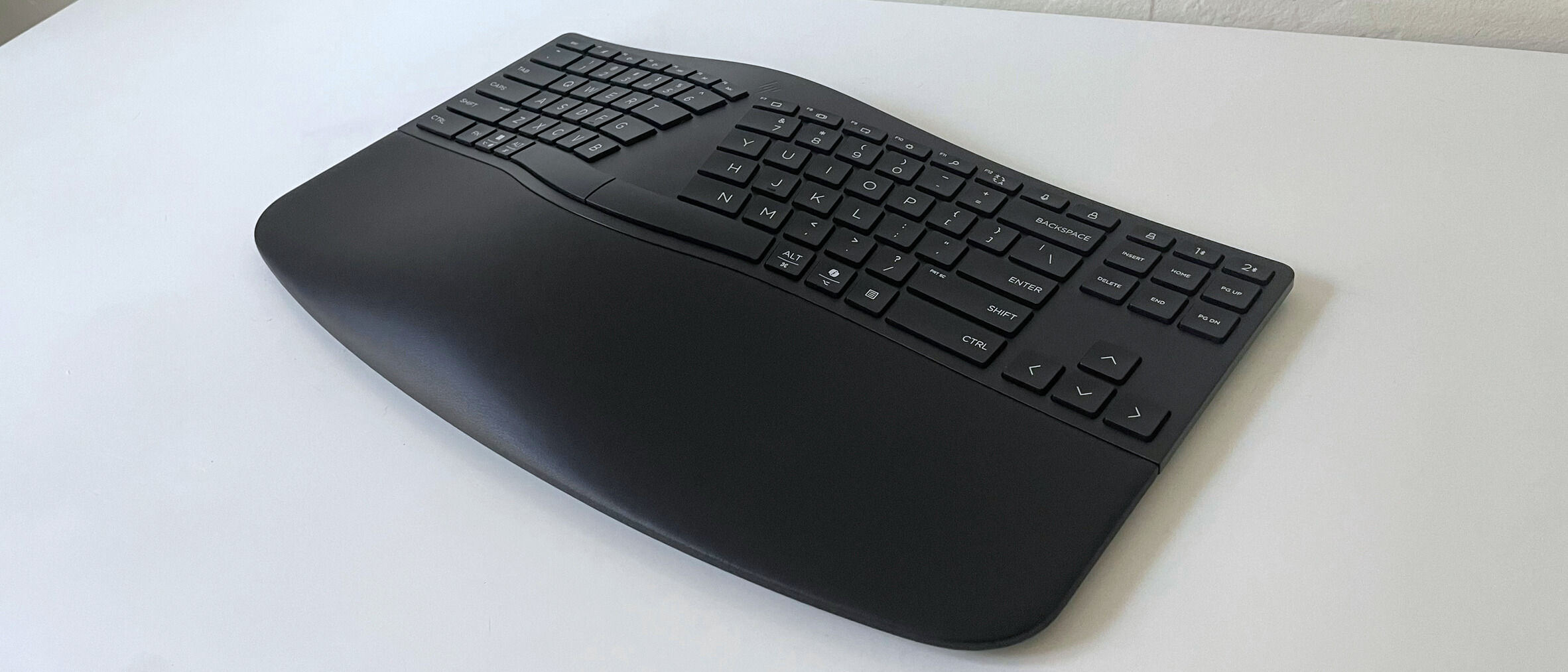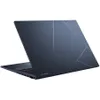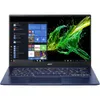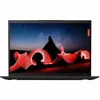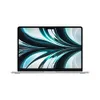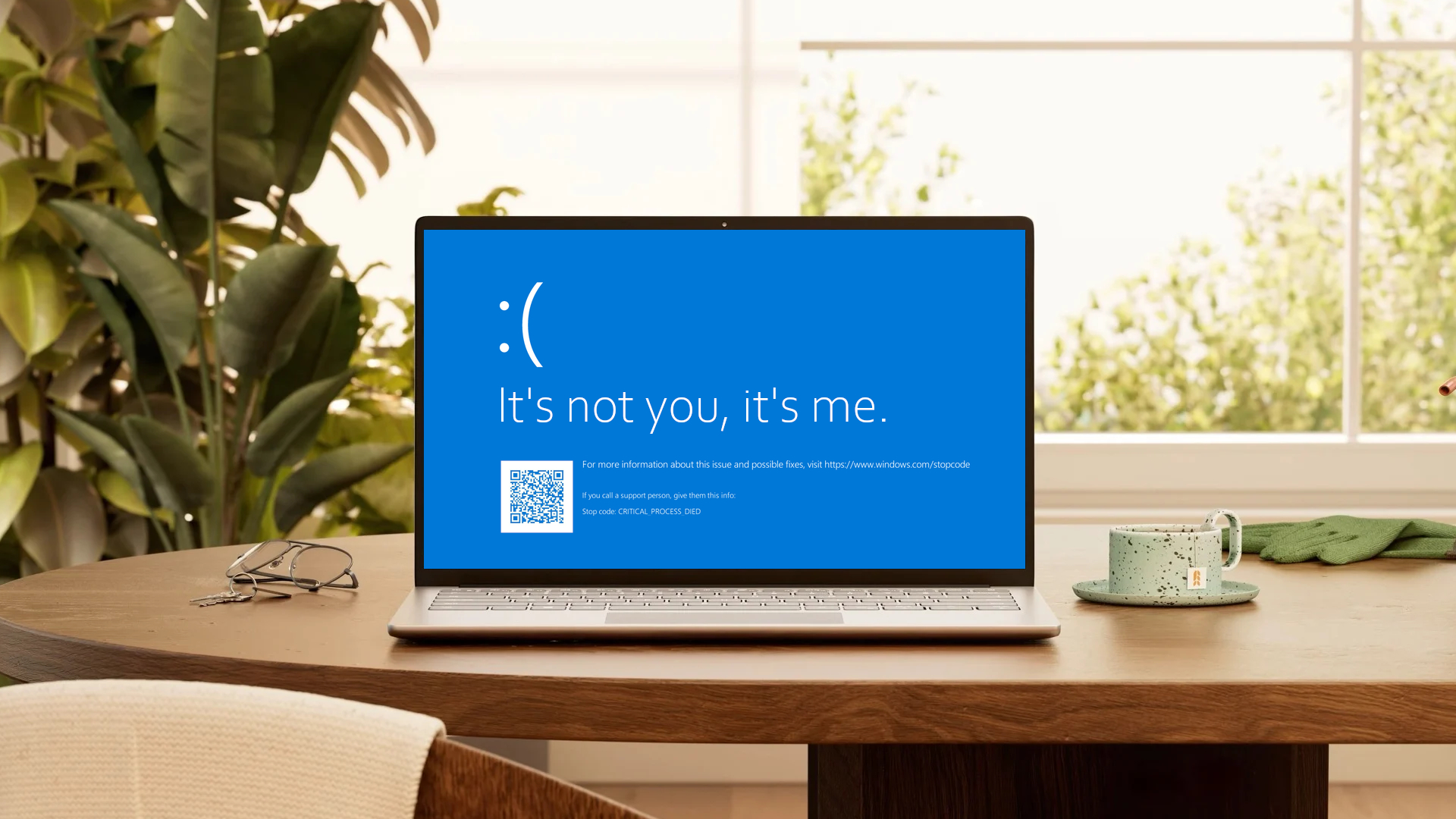Laptop Mag Verdict
The HP 960 Ergonomic Keyboard features a curvy design, and while it comes with a learning curve, the distinctive layout offers a health benefit to just about anyone who works on a computer.
Pros
- +
Supportive, ergonomic design
- +
Dual-mode wireless
- +
Long battery life
Cons
- -
Unique layout is not for everyone
- -
Requires AA batteries
Why you can trust Laptop Mag
Using an ergonomic keyboard for the first time can feel like learning to type all over again, but your hands and wrists might thank you.
I discovered this while testing the HP 960 Ergonomic Wireless Keyboard, which may be the most unique keyboard I’ve tested.
The HP 960 uses a layout with the keys split and angled across a central slope in the middle of the keyboard. It’s similar to an Alice layout but with a vertical slope in the middle. The attached palm rest aims to increase ergonomics even further.
I found the HP 960’s unique design more supportive than a typical laptop or mechanical keyboard.
The health benefits of a keyboard designed for the human body have been studied and the results are inconclusive — but what’s undisputed is that repetitive strain injuries like carpal tunnel syndrome can result from long periods of typing.
While a 2012 study couldn’t present sufficient evidence that ergonomic keyboards were beneficial or harmful for treating carpal tunnel syndrome, I found the HP 960’s unique design more supportive than a typical laptop or mechanical keyboard. However, it really does take some getting used to.
The question is, does this peculiar layout succeed in offering real ergonomic advantages over a conventional laptop or mechanical keyboard? Do those advantages provide valuable benefits for improving productivity or reducing hand cramping? I tested out the HP 960 Ergonomic Wireless Keyboard for a couple of days to find out.
HP 960 Ergonomic Wireless Keyboard: Price and configurations
The HP 960 Ergonomic Wireless Keyboard costs $119 and includes the main keyboard, an unattached number pad, two AA batteries, and a USB dongle. It weighs just 2.04 pounds and measures 15.7 x 9.2 x 1.54 inches.
HP 960 Ergonomic Wireless Keyboard: Design
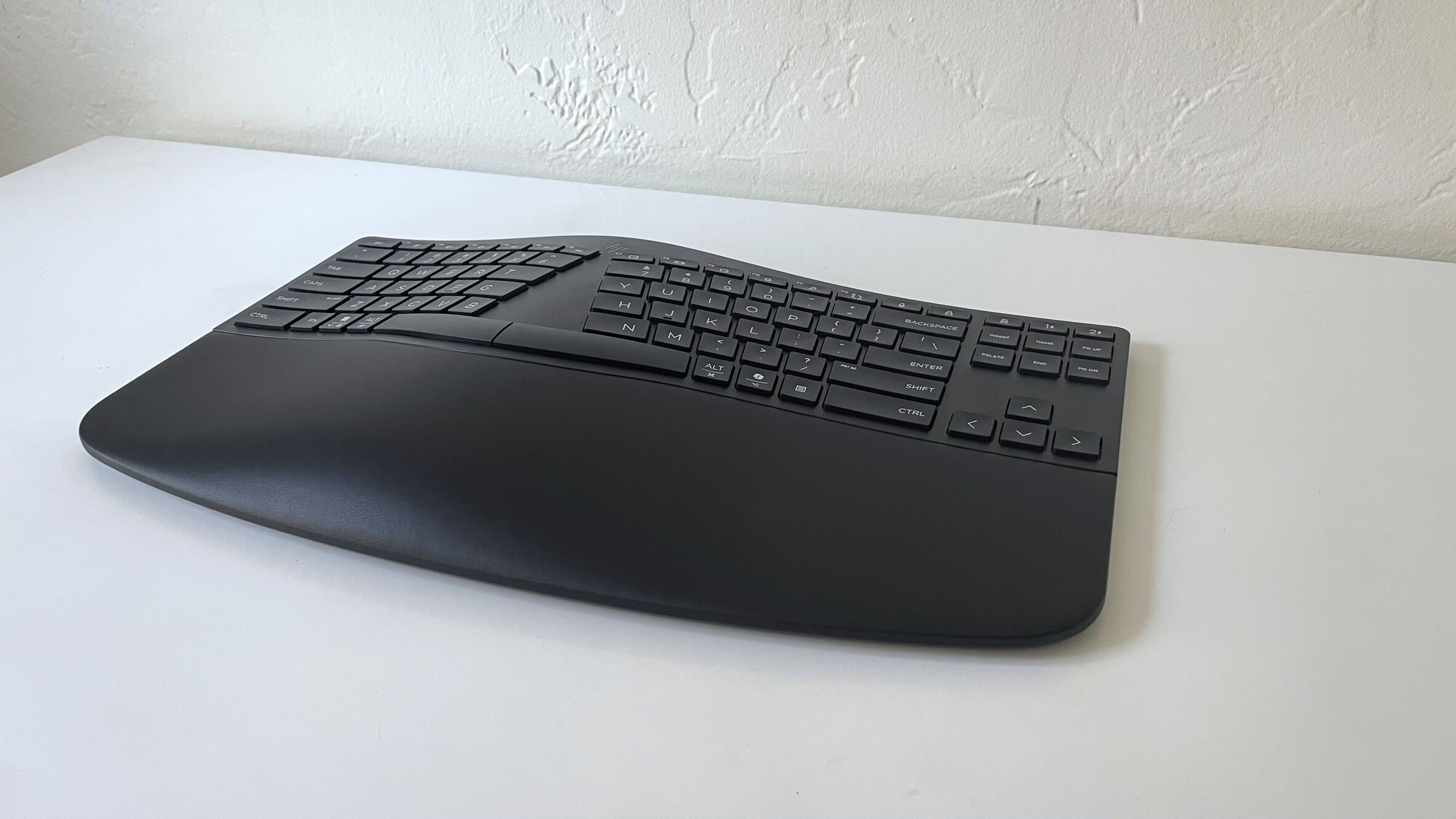
The design is by far the HP 960’s most distinctive feature. It uses a unique layout to improve ergonomics, but it can take some getting used to to type on. The keys are split into two halves, each on one side of a central vertical slope. Plus, the keys are also angled and curved.
Some of the keys are larger than others, as well, to help compensate for the slope in the middle of the keyboard. Even the spacebar is split into two, so you can press it from either side of the keyboard.
The HP 960 would look right at home in any office or workspace. It’s matte black with thin, minimalistic white legends. Along the bottom edge, there is a built-in palm rest that follows the curve of the rest of the keyboard. The palm rest is made of smooth, soft faux leather that matches the matte black plastic of the rest of the keyboard.
The HP 960 would look right at home in any office or workspace.
The HP 960 is a TKL-size keyboard, meaning it has all of the main keys, the function row, and the media keys but does not have a number pad. However, HP includes a separate, flat number pad in the box if those additional keys are necessary for your workflows. The function row keys are pre-assigned to various media functions, such as volume, pause/play, and swapping between up to three connected devices.
The HP 960 even includes a dedicated Microsoft Copilot key, a feature I’ve only seen on Windows laptops up until now. So, if you’re using a Copilot+ PC, you can connect the HP 960 and still have quick access to Copilot through that dedicated key.
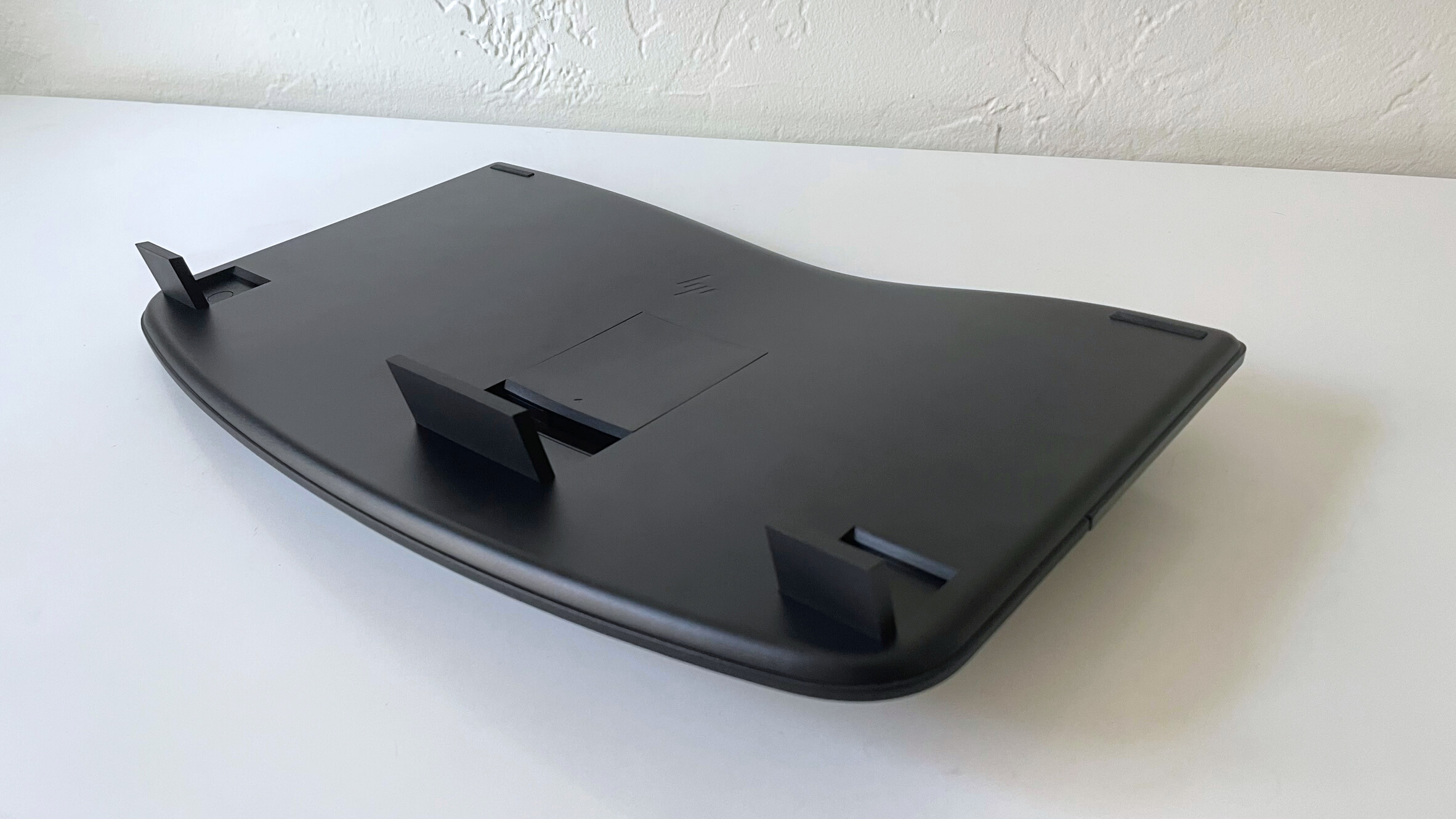
On the bottom of the HP 960, there are three height adjustment feet, all located in unique positions. Two shorter adjustment feet are in the lower right and left corners (rather than the typical placement in the top right and left corners), and one larger adjustment foot is in the center below the battery compartment.
At first glance, that might seem like an unusual layout, but it comes in handy when working at a standing desk. Placing the height adjustment feet in the back corners of the keyboard angles it so the slope and palm rest can still offer support even in a standing configuration. Of course, you can also use them when sitting. For instance, if you’re tall or have a particularly low desk, angling the rear edge of the keyboard upward could improve ergonomics.
HP 960 Ergonomic Wireless Keyboard: Keys
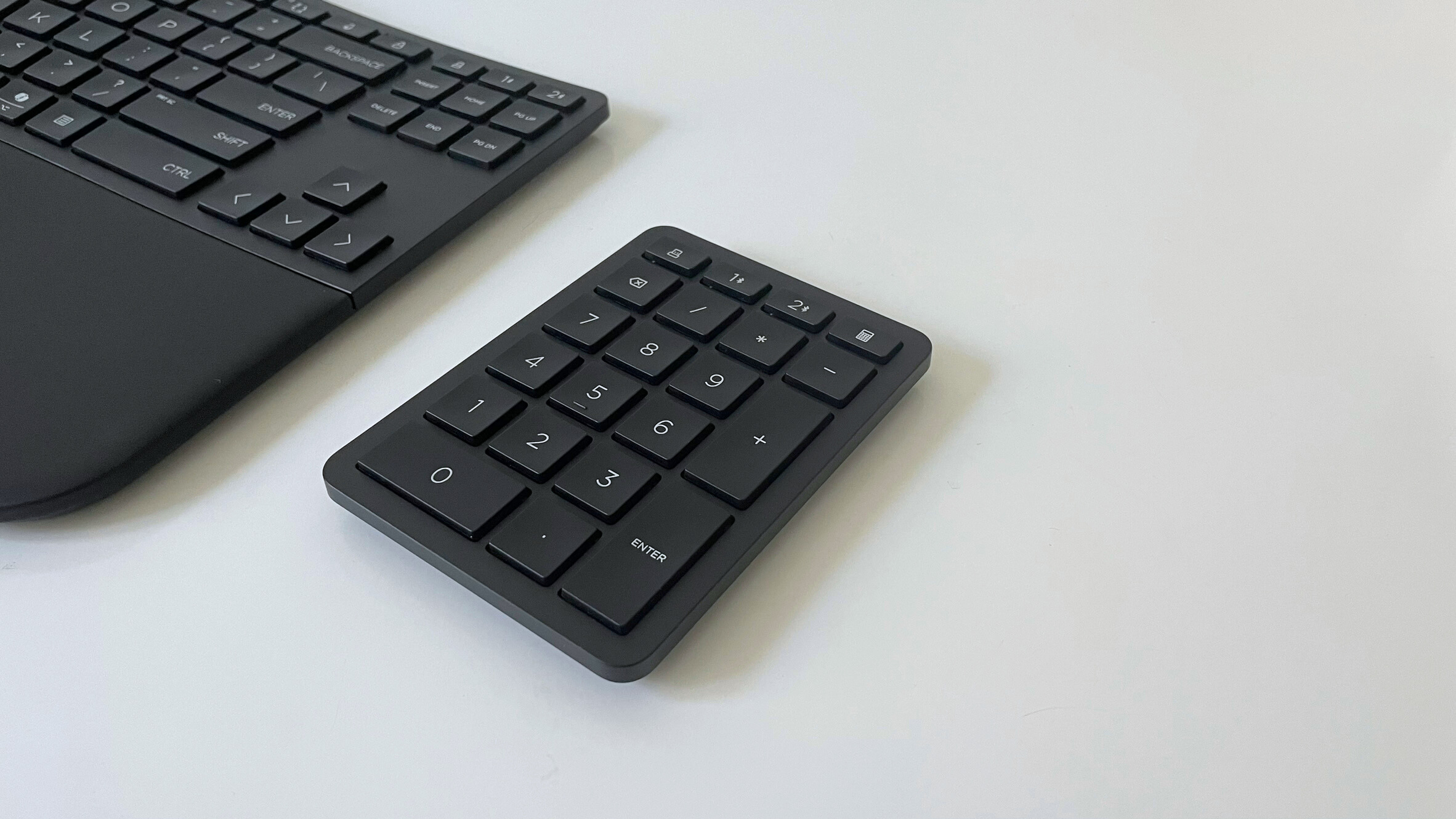
The HP 960 features low-profile keys with scissor switches underneath and 2.0mm of key travel. The typing experience resembles a blend of laptop and mechanical keys. There is a bit more key travel than you would typically get on a laptop keyboard, but the low-profile keycaps are much flatter than those on most mechanical keyboards.
Overall, the typing experience is fairly comfortable and responsive (after you get used to the split, curved layout). The scissor switches are quiet, too, so you won’t bother any of your office neighbors while typing away on the HP 960. There is a bit of tactile feedback when the keys bottom out, but not too much.
The keycaps are made of slightly textured matte black plastic with slightly raised legends. This adds a bit of grip to the keys without making them rough to the touch.
HP 960 Ergonomic Wireless Keyboard: Performance
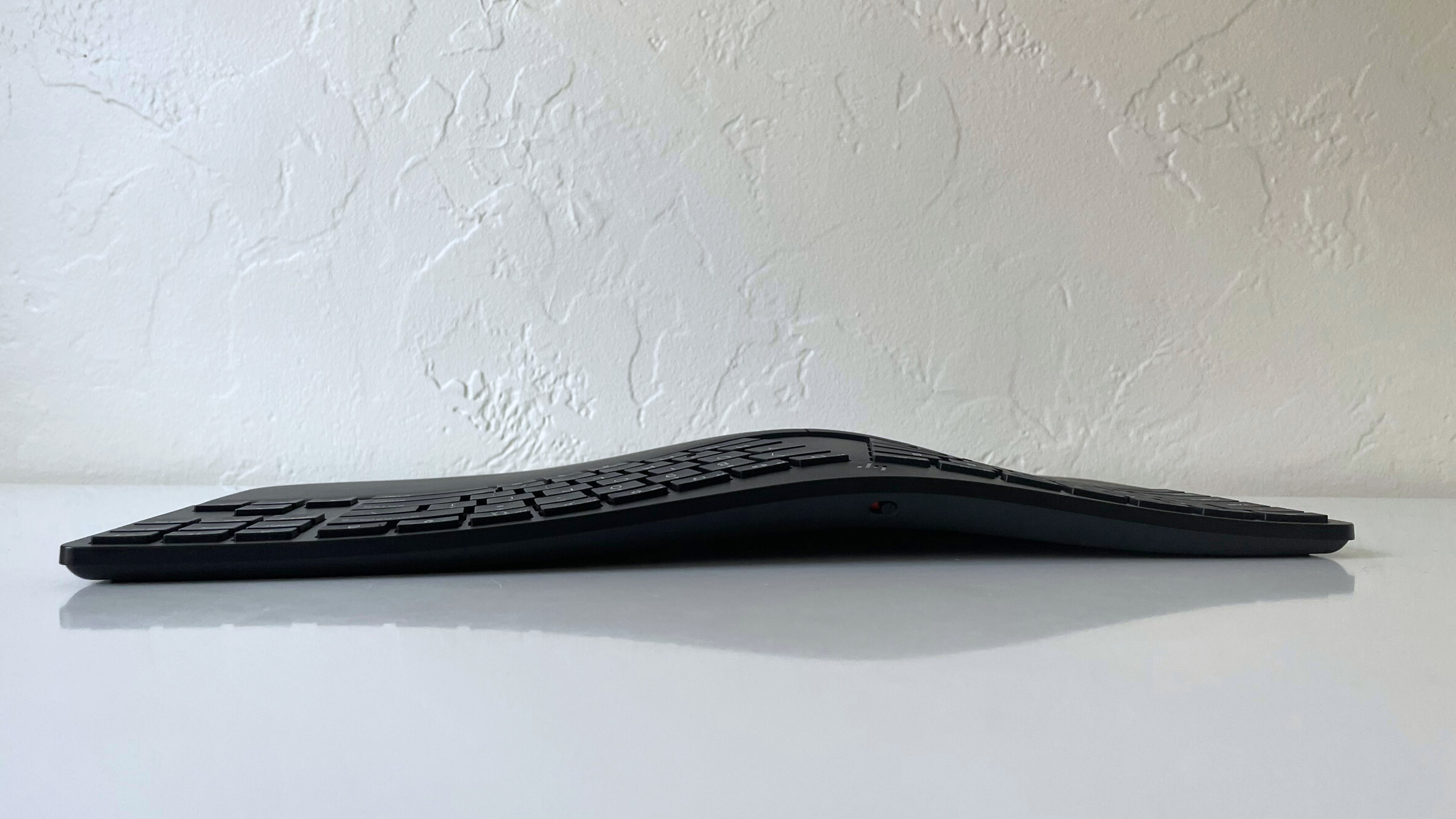
Typing on the HP 960 Ergonomic Wireless Keyboard is an interesting experience. When I first set it out on my desk, I felt like I had to learn to type again. It’s easy to forget, but your typing muscle memory adapts to expect the keys to be in a certain layout. Switching to something as distinctive as the HP 960’s layout can initially throw off that muscle memory.
However, after about half an hour of typing on the HP 960, I noticed myself making fewer errors and typing faster as I adapted. Once you get used to the unique design, typing on it can become more comfortable.
Once you get used to the unique design, typing on it can become more comfortable.
The split, angled layout is designed to bend to the natural angle of your hands when your arms sit on your desk in a neutral position. By splitting the keys in half, the keyboard is effectively angled for both hands at once, rather than forcing you to pick which direction to angle your keyboard or bend both wrists and elbows as you would with a conventional keyboard in a neutral, horizontal position.
The vertical slope in the middle of the HP 960 is angled to offer support across your fingers, hands, and wrists while minimizing the movement necessary to jump between keys. It’s like the keyboard meets your fingers where they are naturally inclined to sit.
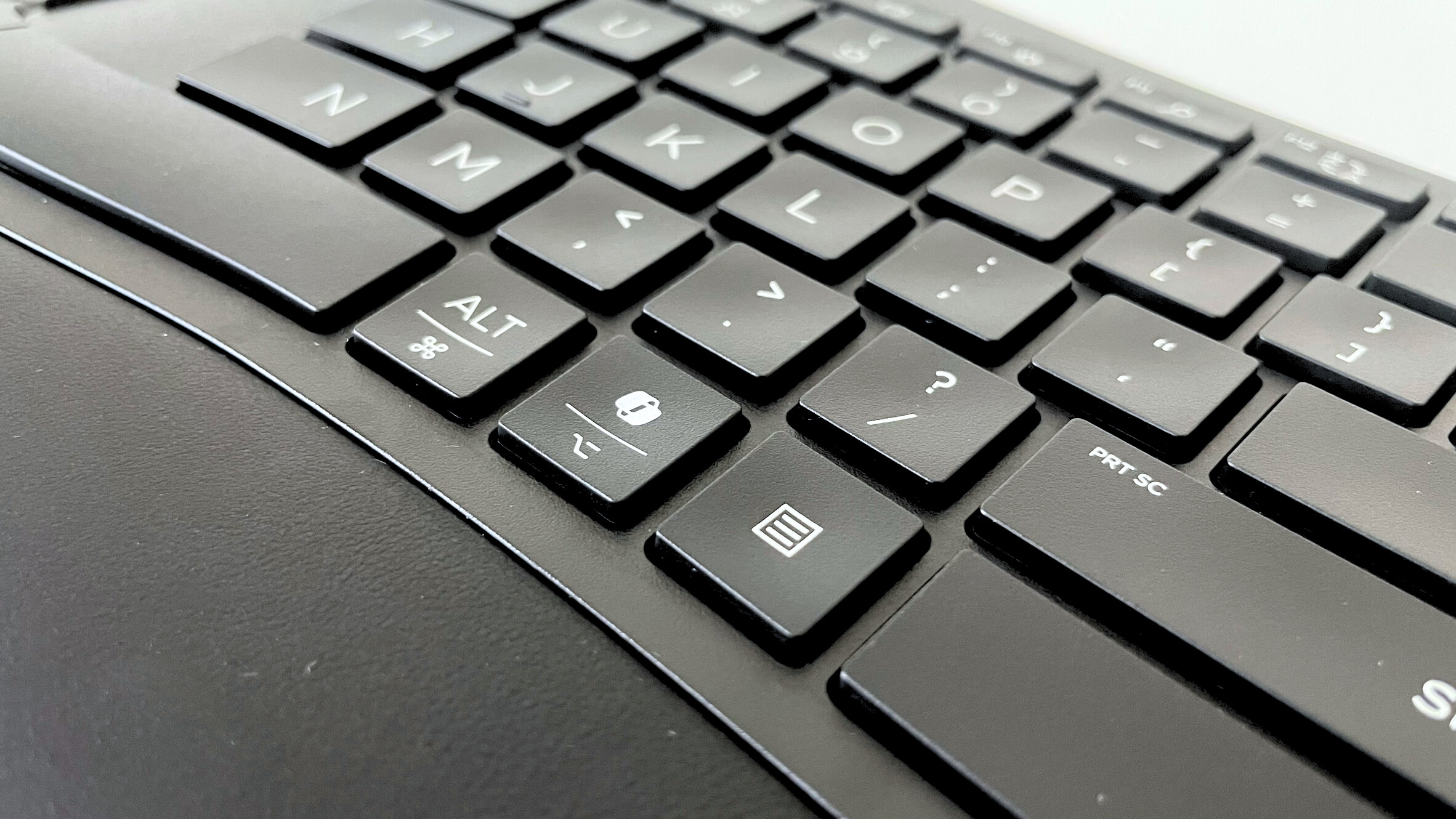
Most people are used to a laptop keyboard's flat, rectangular layout. Adding a keyboard like the HP 960 to your setup may seem unnecessary just for ergonomics. That could be the case for some people, but there is also a case to be made for the HP 960.
This keyboard is designed for people who spend many hours working at a computer everyday, whether at home or the office. If you spend several hours a day typing, an ergonomic keyboard could save you a lot of muscle pain, particularly in your hands, fingers, and wrists.
Desk jobs aren’t normally thought of as dangerous. However, prolonged daily typing sessions can eventually cause repetitive strain injuries in your fingers, hands, and wrists, which could show up as persistent cramping or muscle aches. Plus, the position of your arms and hands on your desk can contribute to neck pain, back pain, and carpal tunnel syndrome.
So, improving the ergonomics of your desk setup has real benefits, like preventing hand cramping, improving comfort, and, by extension, improving productivity and focus. Standing desks are another excellent example of work-related gear designed to improve ergonomics. The HP 960 complements a standing desk well, but it’s also a worthy option for anyone looking to improve the ergonomics of their workspace.
HP 960 Ergonomic Wireless Keyboard: Connectivity and battery life
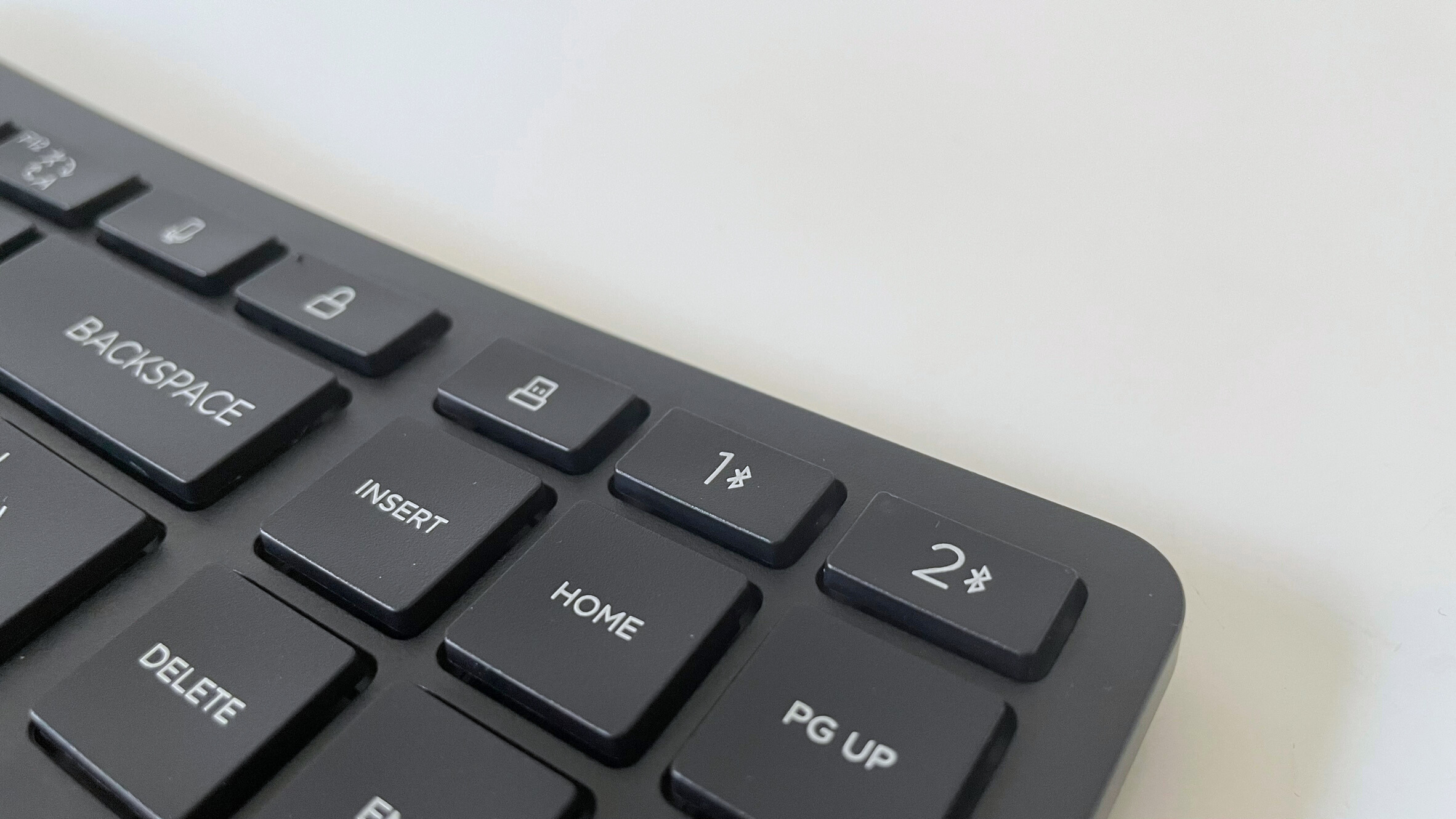
The HP 960 is compatible with Windows 10 and 11, macOS, and ChromeOS. You can connect it using either the included USB Type-A dongle or Bluetooth. The HP 960 can connect to up to three devices simultaneously – one via the dongle and two via Bluetooth. There are convenient dedicated keys in the top right corner of the keyboard for quickly swapping between connected devices.
Unlike most wireless keyboards today, the HP 960 uses two AA batteries rather than a single rechargeable battery. I typically prefer keyboards with a rechargeable battery simply because it avoids the waste of throw-away batteries. However, HP claims the HP 960 has a battery life of up to 2 years, so you won’t need to replace the AA batteries often. Two replaceable CR2032 coin cell batteries power the detached number pad.
Bottom line
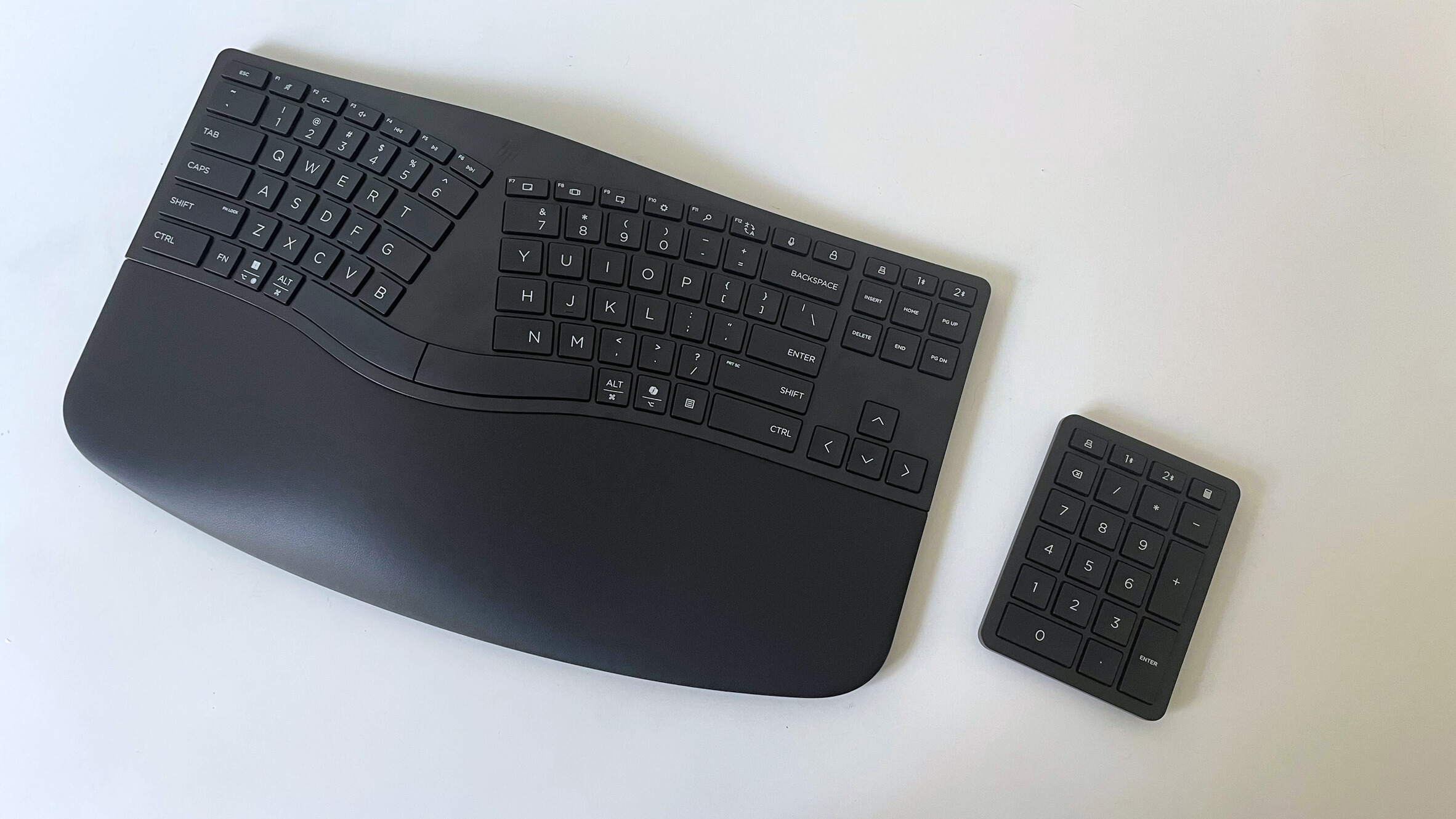
The HP 960 Ergonomic Wireless Keyboard isn’t for everyone. However, it does offer a distinctive design that could be perfect for a unique niche of people aiming to improve the ergonomics of their workspace. From standing desks to vertical mice, there is a growing market for ergonomic desk gear, like the HP 960, designed to help you reduce muscle aches from long days working at your desk.
The HP 960 Ergonomic Wireless Keyboard may be the perfect addition to your desk.
While the unusual layout and sculpted design take a little time to get used to, the HP 960 can be noticeably more comfortable to type on than a conventional keyboard. At $119, it comes at a similar price to other premium keyboards. However, it’s not a mechanical keyboard, so if your heart is set on mechanical switches, you would be better served with one of the best mechanical keyboards.
Typing on the HP 960 can be an eye-opening experience at first because it highlights potential ergonomic issues with your usual typing patterns. I noticed this right away when I started typing on it. While it might not become my daily driver keyboard, its unique shape and layout did help me retrain my muscle memory to be a bit kinder to my muscles.
So, maybe you’re looking to maximize the ergonomics of your workstation, searching for the perfect keyboard to go with your standing desk, or trying to resolve daily cramping from long typing sessions. The HP 960 Ergonomic Wireless Keyboard may be the perfect addition to your desk.
More from Laptop Mag
- Lofree Flow Mechanical Keyboard review: Low-key impressive
- Custom mechanical keyboards vs. pre-built: Should you buy or build your keyboard?
- Best types of mechanical keyboard switches for gaming, typing and more

Stevie Bonifield is a freelance tech journalist who has written for PC Gamer, Tom's Guide, and Laptop Mag on everything from gaming to smartwatches. Outside of writing, Stevie loves indie games, TTRPGs, and building way too many custom keyboards.
